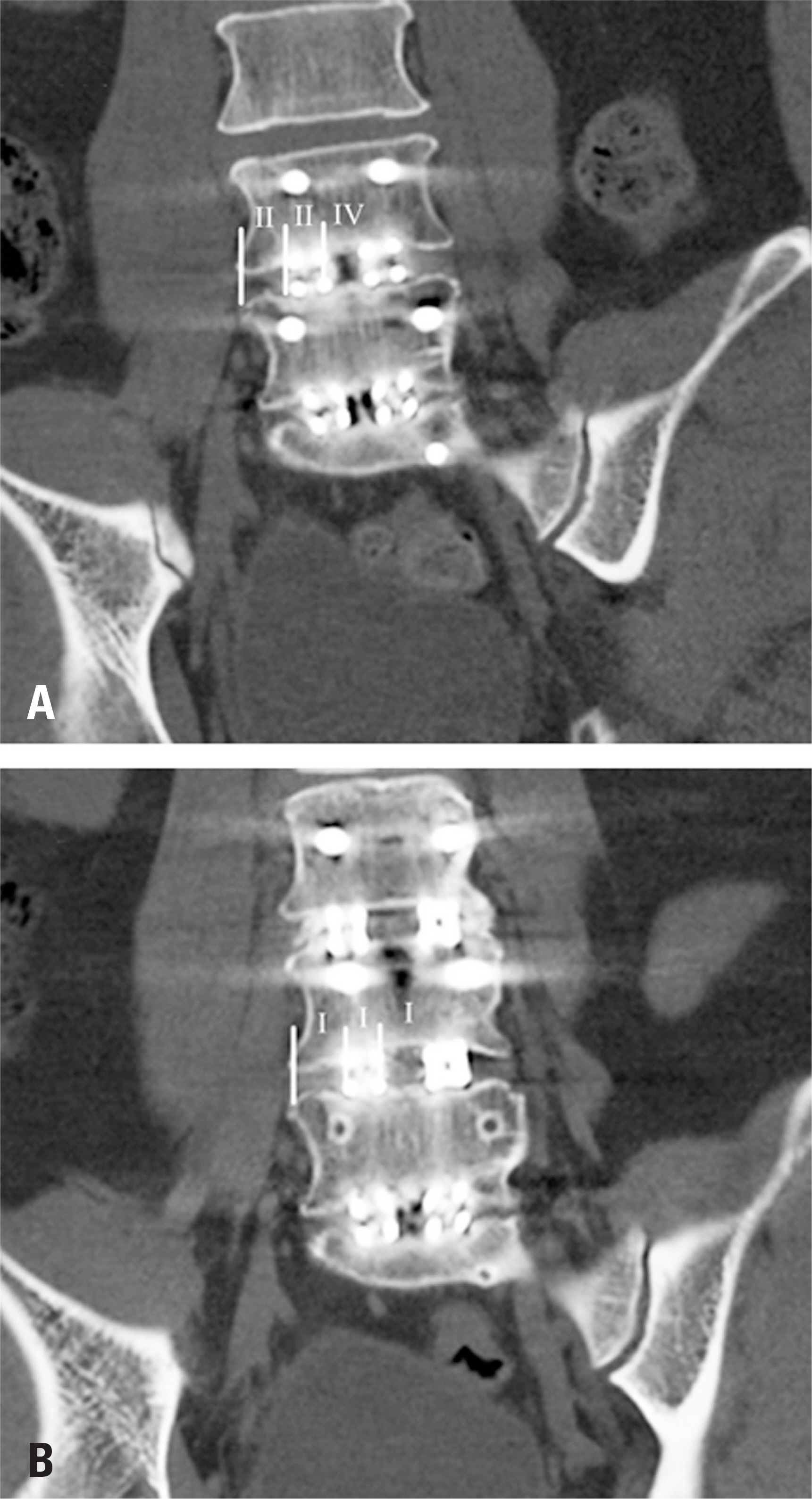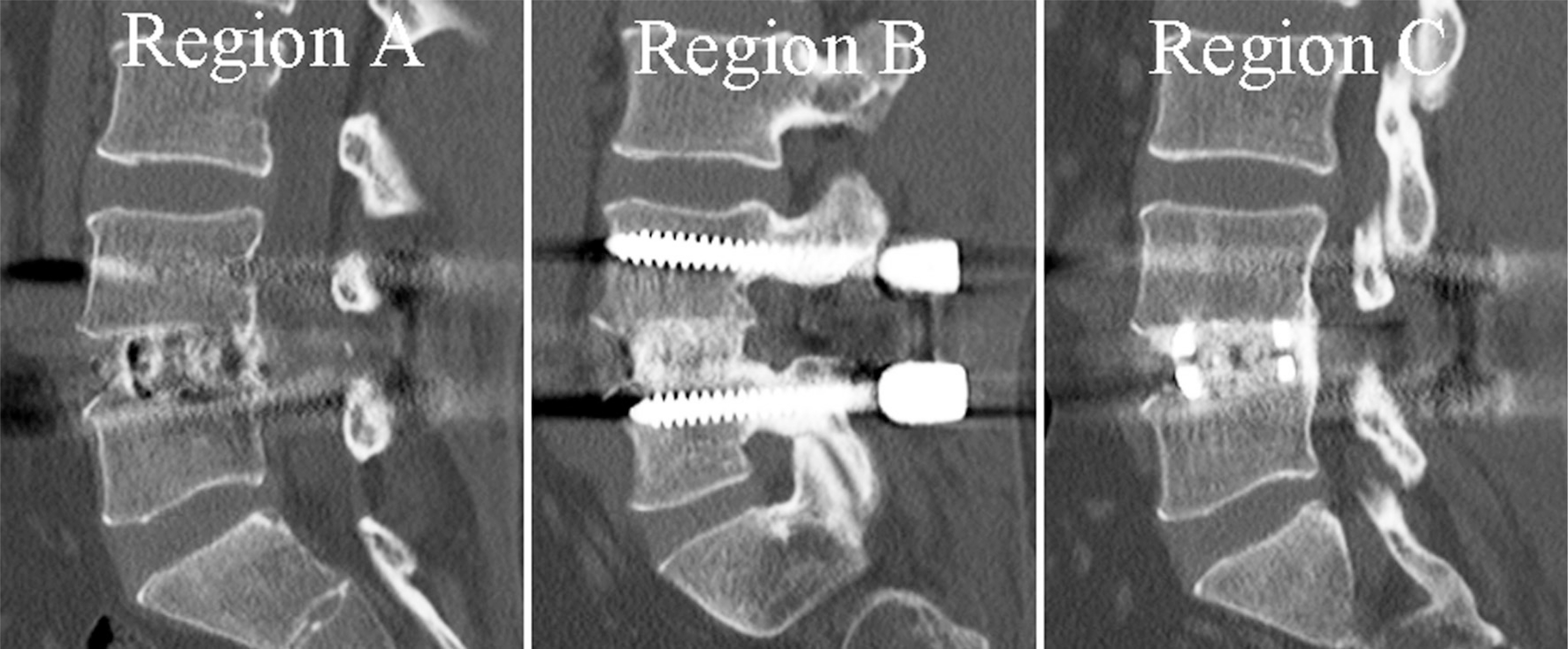J Korean Soc Spine Surg.
2017 Jun;24(2):87-94. 10.4184/jkss.2017.24.2.87.
Union Patterns of Local Autogenous Bone Grafts Using Metal Cages, Allogenic Bone, and Local Autogenous Bone Around the Cages During Posterior Lumbar Interbody Fusion: A Retrospective CT Analysis
- Affiliations
-
- 1Department of Orthopedic Surgery, Yeungnam University Hospital, Daegu, Korea.
- 2Department of Orthopedic Surgery, Soonchunhyang University Bucheon Hospital, Bucheon, Korea. eungha@gmail.com
- KMID: 2385644
- DOI: http://doi.org/10.4184/jkss.2017.24.2.87
Abstract
- STUDY DESIGN: Retrospective study.
OBJECTIVES
To conduct an analysis of the union rate and union patterns of local autogenous bone grafts using metal cages, allogenic bone, and local autogenous bone around the cages in posterior lumbar interbody fusion (PLIF). SUMMARY OF LITERATURE REVIEW: Local autologous bone grafting using metal cages is regarded as an effective method for union during PLIF without iliac bone harvesting. There are few studies about the additional bone grafting except using metal cages.
MATERIALS AND METHODS
Thirty-nine patients (68 segments) with postoperative computed tomography (CT) results from 6 to 18 months after PLIF were included. We used 2 metal cages filled with local autogenous bone intraoperatively (region C). We also grafted allogenic bone between 2 cages (region A) and local autogenous bone at the side of the cages (region B). Retrospective analyses of the coronal CT sections were performed using the modified Bridwell criteria for assessing the presence of union. A quantitative evaluation was performed using a scoring system that assessed the proportion of radiopaque parts of the union mass.
RESULTS
Among the 68 segments, union was observed in 64 segments, resulting in a union rate of 95.6%. The union rates in regions A, B, and C were 86.8%, 89.7%, and 94.1%, respectively. Trabeculation and the quantitative evaluation of union bone showed a statistically significant trend for improvement from regions A to C (p<0.001).
CONCLUSIONS
In this study, the complementary effect of additional bone grafting other than local bone grafting was not proven, but it was effective in increasing the fusion area at around 90%. Keeping the height of disc space with the cages, additional bone grafting using local autogenous and allogenous bone may be used as an effective method for stable union.
Keyword
MeSH Terms
Figure
Reference
-
1. Pitzen T, Geisler FH, Matthis D, et al. Motion of threaded cages in posterior lumbar interbody fusion. Eur Spine J. 2000; 9:571–6.
Article2. Ma GW. Posterior lumbar interbody fusion with specialized instruments. Clin Orthop Relat Res. 1985. 57–63.
Article3. Brantigan JW, Steffee AD, Geiger JM. A carbon fiber im-plant to aid interbody lumbar fusion. Mechanical testing. Spine (Phila Pa 1976). 1991; 16(Suppl):277–82.4. Jorgenson SS, Lowe TG, France J, et al. A prospective analysis of autograft versus allograft in posterolateral lumbar fusion in the same patient. A minimum of 1-year follow-up in 144 patients. Spine (Phila Pa 1976). 1994; 19:2048–53.5. An HS, Lynch K, Toth J. Prospective comparison of autograft vs. allograft for adult posterolateral lumbar spine fusion: differences among freeze-dried, frozen, and mixed grafts. J Spin Disord. 1995; 8:131–5.6. Fernyhough JC, Schimandle JJ, Weigel MC, et al. Chronic donor site pain complicating bone graft harvesting from the posterior iliac crest for spinal fusion. Spine (Phila Pa 1976). 1992; 17:1474–80.
Article7. Ito Z, Imagama S, Kanemura T, et al. Bone union rate with autologous iliac bone versus local bone graft in posterior lumbar interbody fusion (PLIF): a multicenter study. Eur Spine J. 2013; 22:1158–63.
Article8. Chung SS, Lee CS, Lee YS, et al. Posterior Lumbar Inter-body Fusion with Cancellous Allograft. J Korean Soc Spine Surg. 2004; 11:141–6.
Article9. Tuchman A, Brodke DS, Youssef JA, et al. Iliac crest bone graft versus local autograft or allograft for lumbar spinal fusion: A systematic review. Global Spine J. 2016; 6:592–606.
Article10. Kim JH, Hwang JK, Choi YJ, et al. Radiographic comparison of autobone graft and allobone graft in posterolateral lumbar fusion. J Kor Musculoskelet Transplant Soc. 2009; 9:80–7.11. Okuda S, Oda T, Miyauchi A, et al. Surgical outcomes of posterior lumbar interbody fusion in elderly patients. Surgical Technique. 2007; 89:310–20.
Article12. Bridwell KH, Lenke LG, McEnery KW, et al. Anterior fresh frozen structural allografts in the thoracic and lumbar spine. Do they work if combined with posterior fusion and instrumentation in adult patients with kyphosis or anterior column defects? Spine (Phila Pa 1976). 1995; 20:1410–8.
Article13. Hollander M, Wolfe DA, Chicken E. Nonparametric Statistical Methods. Second Edition. Nevo York. John Wiley&Sons Co;1999.14. Blumenthal SL, Ohnmeiss DD. Intervertebral cages for degenerative spinal diseases. Spine J. 2003; 3:301–9.
Article15. Kai Y, Oyama M, Morooka M. Posterior lumbar interbody fusion using local facet joint autograft and pedicle screw fixation. Spine (Phila Pa 1976). 2004; 29:41–6.
Article16. Okuyama K, Kido T, Unoki E, et al. PLIF with a titanium cage and excised facet joint bone for degenerative spondy-lolisthesis-in augmentation with a pedicle screw. J Spinal Disord Tech. 2007; 20:53–9.
Article17. Rapoff AJ, Ghanayem AJ, Zdeblick TA. Biomechanical comparison of posterior lumbar interbody fusion cages. Spine (Phila Pa 1976). 1997; 22:2375–9.
Article18. Fantigrossi A, Galbusera F, Raimondi MT, et al. Biomechanical analysis of cages for posterior lumbar interbody fusion. Med Eng Phys. 2007; 29:101–9.
Article19. Chung SS, Lee JS. Comparison of allograft and autograft in posterior lumbar interbody fusion. J Kor Musculoskelet Transplant Soc. 2004; 4:97–103.20. Thalgott JS, Fritts K, Giuffre JM, et al. Anterior interbody fusion of the cervical spine with coralline hydroxyapatite. Spine (Phila Pa 1976). 1999; 24:1295–9.
Article21. Shah RR, Mohammed S, Saifuddin A, et al. Comparison of plain radiographs with CT scan to evaluate interbody fusion following the use of titanium interbody cages and transpedicular instrumentation. Eur Spine J. 2003; 12:378–85.
Article22. Buser Z, Brodke DS, Youssef JA, et al. Synthetic bone graft versus autograft or allograft for spinal fusion: a systematic review. J Neurosurg Spine. 2016; 25:509–16.
Article23. Thaler M, Lechner R, Gstottner M, et al. The use of beta-tricalcium phosphate and bone marrow aspirate as a bone graft substitute in posterior lumbar interbody fusion. Eur Spine J. 2013; 22:1173–82.
Article24. Kim H, Lee CK, Yeom JS, et al. The efficacy of porous hydroxyapatite bone chip as an extender of local bone graft in posterior lumbar interbody fusion. Eur Spine J. 2012; 21:1324–30.
Article25. Park MJ, Ko YC, Eun IS, et al. Union rates of autologous bone marrow, local autobone and biphasic calcium phosphate mixed graft in lumbar posterolateral fusion. J Korean Soc Spine Surg. 2015; 22:37–42.
Article
- Full Text Links
- Actions
-
Cited
- CITED
-
- Close
- Share
- Similar articles
-
- Local Bone versus Autogenous Iliac Bone Graft for Posterolateral Lumbar Fusion in the Same Patient
- Radiological and Clinical Comparison of 1 Cage versus 2 Cages for Posterior Lumbar Interbody Fusion with PEEK Cage and Local Bone Graft
- Future Development of Interbody Fusion Cages
- Posterior Lumbar Interbody Fusion Using Titanium Cages and Morselized Local Bone Autograft
- Usefulness of Anterior Cervical Interbody Fusion Using Locally Harvested Bone: Locally Harvested Bone Versus Autogenous Iliac Bone






